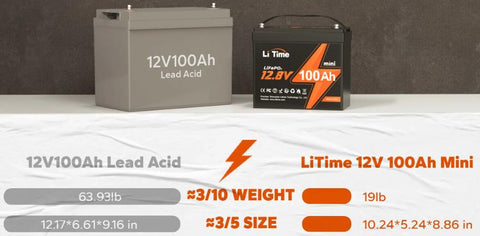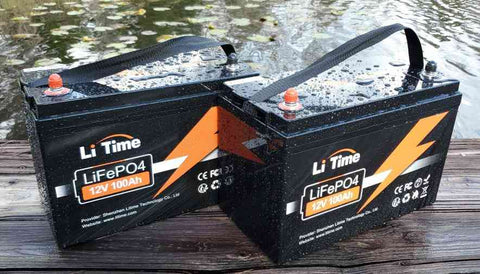5 Reasons to Choose Lithium as Your Trolling Motor Battery
2023-04-20 10:09:10
If you're an avid angler, you know that having a reliable trolling motor is essential for fishing success. But what many anglers overlook is the importance of having a high-quality battery to power their trolling motor. While traditional lead-acid batteries have been the go-to choice for many years, lithium batteries are emerging as a superior option. In this article, we'll discuss why you should choose lithium as your trolling motor battery and how it can improve your fishing experience.
Table of Content
- Reason 1: Lightweight and Portable
- Reason 2: Durability-LiFePO4 is Cost-Effective in the Long Run
- Reason 3: High Energy Density for Increased Performance
- Reason 4: Low Maintenance Requirements
- Reason 5: Advanced Safety Features and Environmentally Friendly
Reason 1: Lightweight and Portable
The weight of a trolling motor battery is an important factor to consider when choosing the right battery for your fishing needs. A heavy battery can negatively impact the speed, maneuverability, and fuel efficiency of your boat, making it difficult to navigate through rough water conditions.
Trolling motors are typically mounted on the bow or stern of a boat and used for extended periods of time at low speeds, so having a battery that is lightweight can help reduce the overall weight of the boat and improve its speed, maneuverability, and fuel efficiency.
In addition, the weight of the battery can affect the balance of the boat and its handling in different water conditions. A heavy battery can cause the bow of the boat to dip and make it harder to steer in rough water, while a lighter battery can help maintain the boat's stability and responsiveness.
Compared to traditional gel cell and AGM batteries, lithium iron phosphate (LiFePO4) batteries offer a significant weight savings that can make a big difference in the performance of your trolling motor. While a 12V 100Ah gel cell or AGM battery typically weighs between 60-70 lbs, a Litime 12V 100Ah mini LiFePO4 battery only weighs 19 lbs.

This means that with up to three batteries on board, you could save as much as 123 lbs in weight, reducing pressure on the engine and freeing up more weight allowance for your catch. These weight savings can improve the speed, maneuverability, and fuel efficiency of your boat, allowing you to spend more time on the water and less time worrying about battery weight.
Reason 2: Durability-LiFePO4 is Cost-Effective in the Long Run
Trolling motors put significant strain on batteries, especially during extended periods of use in varying water conditions and speeds. A battery that lacks durability may fail prematurely, leaving you stranded on the water with no power for your motor.
In contrast, a more durable battery can handle repeated use over time without losing its capacity or performance. This ensures reliable power for your trolling motor whenever you need it and saves you money in the long run by reducing the need for frequent battery replacements, which can be costly and time-consuming.
Another important aspect to consider is the expected lifespan of the battery. A more durable battery typically lasts longer than a less durable one. Lithium iron phosphate (LiFePO4) batteries, for instance, have 3-5 times longer lifespans than lead-acid batteries. While lead-acid batteries have a cycle life of around 300-500 (meaning they need to be replaced every 2-3 years), LiFePO4 batteries have a cycle life of 4,000-15,000 cycles (meaning they can be used for more than 10 years).

Choosing a battery with a long lifespan can help you avoid the hassle and expense of frequent battery replacements while ensuring that your trolling motor has the power it needs for optimal performance on the water.
Reason 3 : High Energy Density for Increased Performance
Lithium iron phosphate (LiFePO4) batteries have a higher energy density than other types of batteries, including lead-acid batteries. This means that LiFePO4 batteries can store more energy in a smaller size and weight compared to lead-acid batteries. The energy density of a typical lead-acid battery is around 30-50 Wh/kg, while a typical LiFePO4 battery has an energy density of around 100-150 Wh/kg. This translates into increased performance for your trolling motor, as LiFePO4 batteries can provide more power to the motor for a longer period of time.
The higher energy density of LiFePO4 batteries also allows them to maintain a consistent voltage output, which is crucial for peak performance of your trolling motor. Consistent voltage output means that the motor will operate at a steady speed without any fluctuations or disruptions, providing a smooth and efficient experience on the water.
Additionally, LiFePO4 batteries are able to discharge at a higher rate than lead-acid batteries, with discharge rates of up to 5C or more compared to 1C-2C for lead-acid batteries. This allows the battery to deliver more power to the trolling motor when it's needed, providing increased performance and longer run times on the water. Here's a review of an angler who changed the battery to LiFePO4.

In summary, the higher energy density of LiFePO4 batteries provides increased performance and longer run times for your trolling motor. Their ability to store more energy in a smaller size and weight, maintain a consistent voltage output, and discharge at a higher rate makes them the ideal choice for powering your outdoor adventures, while being more cost-effective in the long run due to their longer lifespan and lower maintenance requirements.
Reason 4: Low Maintenance Requirements
Proper maintenance is crucial to ensure optimal performance and lifespan of a trolling motor battery. When choosing a battery, accessibility for maintenance should be considered as some batteries may be difficult to access.
The amount of maintenance required can impact your overall fishing experience. A battery that requires regular maintenance such as checking water levels, adding distilled water, and ensuring proper charging can be inconvenient and time-consuming, taking away valuable fishing time on the water.

Lead-acid batteries, for example, require regular maintenance, and neglecting these tasks can lead to reduced battery life or even battery failure, leaving you stranded on the water with no power for your trolling motor.
In contrast, LiFePO4 batteries are considered "maintenance-free" because they require much less maintenance than lead-acid batteries. LiFePO4 batteries do not need to be checked regularly for water levels, and they do not require any special charging considerations to ensure their longevity. Learn how to maintain LiFePO4 battery on The Ultimate Guide To LiFePO4 Battery Maintenance: Keep Your Power Going Strong. Choosing a LiFePO4 battery can save time and effort on maintenance tasks and provide a hassle-free fishing experience on the water.

Therefore, battery maintenance is a critical aspect to consider when choosing a trolling motor battery, and opting for a low-maintenance option like a LiFePO4 battery can provide benefits in terms of time, effort, and overall performance on the water.
Reason 5: Advanced Safety Features and Environmentally Friendly
Safety is a crucial concern when it comes to trolling motor batteries, as overcharging and undercharging are the main safety hazards. Overcharging can cause overheating, which may lead to battery rupture or explosion, whereas undercharging can damage the battery and reduce its performance.
Another safety concern is the release of toxic gases during charging or use. Lead-acid batteries, for example, can emit hydrogen gas, which is highly flammable and poses a risk of explosion or fire if not appropriately vented. LiFePO4 batteries, on the other hand, do not emit toxic gases, making them a safer choice for enclosed spaces such as boats.
To ensure battery safety for your trolling motor, it's crucial to choose a battery that incorporates advanced safety features, including overcharge protection, thermal regulation, and short-circuit prevention mechanisms. It's also essential to store and use your battery in a well-ventilated area, away from heat sources and flames.
LiTime's LiFePO4 batteries come with built-in BMS (Battery Management System), ensuring overcharge, over-discharge, over-current, short circuit, and high-temperature protection, thereby providing optimal battery safety and reliability.
The LiTime trolling motor series, with basic protections mentioned above, are designed for harsh environments such as rainy or coastal areas, or dusty and wet conditions providing moisture, dust and salt spray resistance for reliability in humid environments.

By selecting a battery with advanced safety features and following proper storage and usage guidelines, you can minimize the risks associated with battery use and enjoy a safe and worry-free experience on the water with your trolling motor.
Conclusion
A high-quality trolling motor battery is essential for any outdoor enthusiast, and lithium batteries offer numerous advantages over traditional lead-acid batteries. With their higher energy density, longer lifespan, low maintenance requirements, lightweight and portable design, safety features, and environmental friendliness, lithium batteries are the ideal choice for powering your trolling motor and other outdoor adventures. By investing in a top-quality lithium battery, you can enjoy increased performance, longer run times, and peace of mind on the water.
You may also like
<<< Unlock More Power - Top Tips For Expanding Your Battery Bank That’s Already In Use
<<<Selecting The Ideal Battery Size For Your Trolling Motor: Everything You Need To Know
Video collection
Product information
Recommended

LiTime 12V 100Ah TM Lithium Marine Trolling Motor Battery

LiTime 12V 100Ah TM Lithium Marine Trolling Motor Battery

LiTime Group 24/27/31 Marine Battery Box, Built-in Voltmeter

LiTime 500A Battery Monitor With Shunt

LiTime 12V (14.6V) 10A Lithium Battery Charger IP65 Waterproof

LiTime 12V 12Ah LiFePO4 Lithium Battery for Fish Finder
Product information

LiTime 12V 100Ah TM Lithium Marine Trolling Motor Battery
SPECS
FAQ
USER MANUAL
BATTERY
Cell Type:
LiFePO4 Prismatic
Warranty:
5 Years
Cycle Life:
4000 cycles at 100% DOD, 6000 cycles at 80% DOD, 15,000 cycles at 60% DOD
Nominal Voltage:
12.8V
Rated Capacity:
100Ah
Energy:
1280Wh
Max. Expansion (Parallel & Series):
4P4S
Internal Resistance:
≤40mΩ
Certifications:
UL, FCC, CE, RoHS, UN38.3
Bluetooth:
/
BMS
BMS:
100A
Max. Continuous Output Power:
1280W
Max. Continuous Charge Current:
100A
Max. Continuous Discharge Current:
100A
Max. Discharge Current 5 Seconds:
300A
Max. Discharge Current 1 Second:
500A
CHARGE
Charge Method:
CC/CV
Charge Voltage:
14.4V ± 0.2V
Recommend Charge Current:
20A (0.2C)
TEMPERATURE
Charge Temperature:
0℃ to 50℃ / 32℉ to 122℉
Discharge Temperature:
-20℃ to 60℃ / -4℉ to 140℉
Storage Temperature:
-10℃ to 50℃ / 14℉ to 122℉
Low-Temperature Protection:
√
Low-Temperature Charging Protection Auto Recovery:
Yes (41℉/5℃)
OTHERS
Terminals:
M8 bolts
Weight Approx.:
23.4 lbs
Size:
13*6.77*8.43 in (group 31 size)
Housing Material:
ABS
Protection Class:
IP65
Q: Can I use the trolling motor battery in my outboard motor?
A:
Normally, it's not recommended to use a battery designed for a trolling motor in an electric outboard motor since the surge discharge current might not be sufficient. Outboard motors often require higher power for acceleration and sustained operation, which can lead to higher surge currents that trolling motor batteries may not handle well.
If you’re planning to use an electric outboard motor, it’s best to invest in a battery specifically designed for such applications like LiTime Outboard Motor Batteries. These batteries are built to handle the high power requirements and ensure optimal performance and safety.
Read on Electric Outboad Motor VS Trolling Motor for more detailed information.
Q: How long will a 100Ah lithium battery run a trolling motor?
A:
The run time of your trolling motor depends on the amp hour (Ah) capacity of your battery and the motor's current draw. Follow this simple formula:
Run Time (hours) = Battery Capacity (Ah) / Motor Current Draw (A)
For example:
Your trolling motor draws 54A at full throttle. You have a 100Ah battery.
Run Time = Battery Capacity / Current Draw
= 100Ah / 54A
= 1.85 hours
= 1 hour and 51 minutes
So the 100Ah battery would run the 54A motor for about 1 hour 51 minutes at full speed.
To find low speed run time:
If the motor draws 10A at half throttle.
Run Time = Battery Capacity / Current Draw
= 100Ah / 10A
= 10 hours
Q: Can I use LiTime 12V 100Ah TM LiFePO4 lithium batteries as starting batteries?
A:
No. LiTime LiFePO4 lithium batteries are not intended to be used as starting batteries but deep cycle energy storage, please do not use them to start any devices.
If you need the marine starting batteries, visit LiTime 12V 20Ah Marine Cranking or 12V 140Ah Dual Purpose battery to choose.
For more information to tell the differeces among these 2 types batteries, read on our blog Deep Cycle VS Starting Marine Battery.
Q: Can I charge LiTime 12V 100Ah TM LiFePO4 lithium batteries in cold weather (under freezing temperatures)?
A:
LiTime 12V 100Ah TM LiFePO4 batteries can charge between 32°F to 113°F (0°C to 45°C). The 12V 100Ah TM version has low-temperature charging protection function, it would cut off charging when it's below 0℃.
Q: How to charge LiTime 12V 100Ah TM lithium batteries?
A:
1. Using Solar Panels
The battery can be fully charged in one day (with effective sunshine 4.5 hrs/day) by 300W solar panels. It may take more than one day to fully charge the battery by ≥300W solar panels since the duration and intensity of light would be a great factor for their charging efficiency.
Besides solar panels, there are 2 more ways to charge. Suggest reading: 3 reliable ways to charge LiFePO4 lithium batteries
2. Generator/Alternator
If the alternator or generator supports DC output, a DC-to-DC charger is needed to connect the battery to the generator; if your alternator or generator supports AC output, please add a suitable battery charger to connect the battery and the generator according to our recommendations. The Recommended Charging Voltage: 14.2V - 14.6V. The Recommended Charging Current: ① 20A (0.2C): the battery will be fully charged in around 5 hrs to 100% capacity; ② 50A (0.5C): the battery will be fully charged in around 2 hrs to around 97% capacity.
3. LiFePO4 Smart Chargers
To charge 12V battery, it is recommended to use 14.6V battery charger.
The Recommended Charging Voltage: 14.2V - 14.6V.
The Recommended Charging Current: ① 20A (0.2C): the battery will be fully charged in around 5 hrs to 100% capacity; ② 50A (0.5C): the battery will be fully charged in around 2 hrs to around 97% capacity.
Q: Can I connect the batteries more than 4 in parallel?
A:
During use, inconsistencies between cells can increase over time. When connecting too many batteries in parallel, this can cause faster degrading batteries to trigger protection and fail prematurely. Therefore, paralleling more batteries is not always better. The industry standard maximum is 4 paralleled batteries.
Q: Does LiTime lithium trolling motor battery meet ABYC E-13 standards?
A:
Yes. LiTime Deep Cycle Trolling Motor Lithium Batteries meet the ABYC E-13 standard, ensuring they are safe and compliant for use in marine environments.
Whether you're powering a trolling motor, fish finder, or other onboard electronics, you can trust LiTime batteries to deliver reliable, marine-grade performance.
Video collection
1

3 Must-Know Steps To Take Right After Unboxing
2

How to Connect the Battery With Your Appliance
3

5 Reasons to Choose Lithium as Your Trolling Motor Battery
4

How to Wiring Batteries in Series and Parallel with LiTime Power!
5

How to Connect a 2P2S Battery System with LiTime
6

How to Connect Your Battery with Appliance by Inverter
How was your experience using our product/service?

Sign Up Newsletter
Get the latest updates, special offers and more!
 Email subscription successful.!
Email subscription successful.!
7% order discount coupon
TQ90-IGH71
copied
● Discount coupons are limited to use during Black Friday
- Choosing a selection results in a full page refresh.





























































































































 30-Day Price Guarantee
30-Day Price Guarantee





